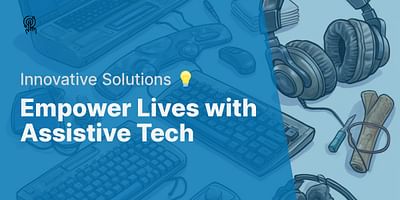Arthur is a seasoned UX designer and an authority in the field of accessibility consultancy. With a proven track record of collaborating with a multitude of companies, he has significantly enhanced the accessibility of their products. Arthur is driven by a fervor for crafting user experiences that are all-embracing and inclusive.
Hey there! I'm Ethan, and I'm here to help you navigate the world of assistive technology for seniors. Conducting a needs assessment is an essential first step in finding the right assistive technology that meets your unique requirements. Let's dive into the process together!
Step 1: Identify Goals and Challenges
To begin, take some time to reflect on your goals and challenges. What specific tasks or activities do you find difficult or impossible to do independently? Are there any areas where you would like to enhance your abilities? Understanding your goals and challenges will help guide the rest of the assessment process.
Step 2: Consult with Professionals
Next, it's a good idea to consult with professionals who specialize in assistive technology or disability services. These experts can provide valuable insights and recommendations based on your specific needs. Reach out to occupational therapists, speech-language pathologists, or assistive technology specialists who can guide you through the process.
Step 3: Evaluate Physical Abilities
Assessing your physical abilities is crucial in determining the right assistive technology. Consider factors such as vision, hearing, mobility, and dexterity. For example, if you have low vision, you may benefit from a screen reader or magnification software. If you have limited hand mobility, a one-handed keyboard or voice-controlled device might be helpful.
Step 4: Consider Cognitive Abilities
In addition to physical abilities, it's important to consider cognitive abilities. Some seniors may experience memory loss, difficulty with attention, or other cognitive challenges. Speech-to-text software or reminder apps can be useful in these situations. Take note of any cognitive difficulties you face, as this will help narrow down the options.
Step 5: Explore Assistive Technology Options
Once you have a clear understanding of your goals, challenges, and abilities, it's time to explore the wide range of assistive technology options available. Research and try out different devices, software, and apps that align with your needs. Consider factors such as ease of use, compatibility with your existing devices, and the level of support available.
Step 6: Seek User Feedback
While researching, don't forget to seek feedback from other users. Online forums, support groups, and social media communities can be great resources for gathering insights and recommendations from people who have firsthand experience with different assistive technologies. Their feedback can help you make more informed decisions.
Step 7: Trial and Adjust
Once you've narrowed down your options, it's time to try out the assistive technology in real-life scenarios. Many companies offer trial periods or return policies, allowing you to test the product and ensure it meets your needs. During this trial period, take note of any adjustments or customizations that may be necessary to optimize your experience.
Step 8: Seek Ongoing Support
Finally, remember that the journey doesn't end once you've found the right assistive technology. Ongoing support is crucial for a successful experience. Reach out to the manufacturer or assistive technology specialist for any technical assistance or training you may need. They can help you maximize the benefits of the technology and address any challenges that arise.
Remember, the needs assessment process is unique to each individual. By following these steps and seeking guidance from professionals, you'll be well on your way to finding the perfect assistive technology that empowers you to live life to the fullest.
I hope this helps! If you have any more questions, feel free to ask.












